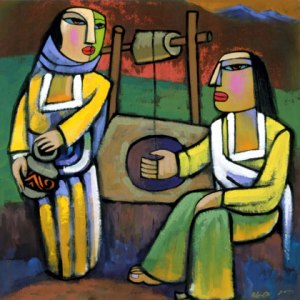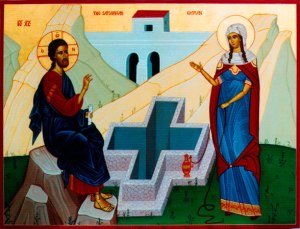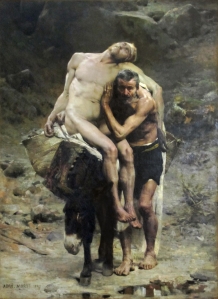
“Jesus Teaches a Samaritan Woman” The Mormon Channel video (LDS Church, circa 2012). Click to watch.
An ongoing series of articles on some common and recurring weak arguments that Christians make against Mormonism.
by Fred W. Anson
The Argument:
“I don’t need to understand Mormon culture or learn how to speak like a Mormon! I won’t stoop to the level of heretics – after all, Jesus and the Apostles never did!”
Why It’s Weak:
This stance is impossible to defend since Jesus and the Apostles did learn other cultures and related to them where they were in order to reach them with the gospel – and this included heretics.
Meet the Samaritans
Who does this sound like?
- They’re heretics yet they claim that they are the only true and living church.
- They claim that all other churches are apostate.
- The founding of their religion was strongly opposed, criticized and denounced by the established church at that time.
- Many members claim to be from the House of Joseph – descendants of the tribes of Ephraim and Manasseh.
- They have a a view of God that differs from the larger mainstream orthodox church’s view.
- They believe in pre-existence.
- They claim that the current church’s scripture is corrupt – deliberately infused with an apostate agenda. That is, it’s truth intermingled with the vain philosophies of men not God.
- They claim to be the sole possessors of the original, pure and uncorrupted Bible – a bible which discards books in the established church’s canon, and that is very different on key points of doctrine relative to that canon.
- They have additional sacred texts which, while not formally canonized, maintain a quasi-canonical status.
- Critics claim that portions of their theology is syncretistic, incorporating outside cultures and religions.
- They have their own priesthood system.
- They have a temple system that deviates strongly from the Levitical system given in the bible.
- They claim that their temple, rather than the Jewish temple in Jerusalem, is the correct place set apart by God for special ceremonies and worship.
- Outside critics and scholars throughout history have disputed the veracity and historicity claims of their scripture as well as their origin story.
They, of course, are the Samaritans of Christ’s day – who did you think I was talking about? But joking aside, it’s not hard to see how much the Samaritanism of Christ’s day parallels today’s Mormonism.[1] Thus whenever I hear someone rhetorically ask, “I wonder how Christ would have engaged Mormonism had it been around in His day?” I say, “We already know!”

Scene of the meeting of Christ with the Samaritan woman at the well from a fresco in the side wall of the refectory in the Monastery Ambramowickiego, Przypusta, Poland
That said, here’s a short debriefing on the Samatarians:
The Samaritans occupied the country formerly belonging to the tribe of Ephraim and the half-tribe of Manasseh. The capital of the country was Samaria, formerly a large and splendid city. When the ten tribes were carried away into captivity to Assyria, the king of Assyria sent people from Cutha, Ava, Hamath, and Sepharvaim to inhabit Samaria (2 Kings 17:24;Ezra 4:2-11). These foreigners intermarried with the Israelite population that was still in and around Samaria. These “Samaritans” at first worshipped the idols of their own nations, but being troubled with lions, they supposed it was because they had not honored the God of that territory. A Jewish priest was therefore sent to them from Assyria to instruct them in the Jewish religion. They were instructed from the books of Moses, but still retained many of their idolatrous customs. The Samaritans embraced a religion that was a mixture of Judaism and idolatry (2 Kings 17:26-28). Because the Israelite inhabitants of Samaria had intermarried with the foreigners and adopted their idolatrous religion, Samaritans were generally considered “half-breeds” and were universally despised by the Jews.[2]
And in addition to these racial and theological issues, the Jews had plenty of other good reasons to stay in hardhearted, ignorant, bigotry toward the Samaritans:
1. The Jews, after their return from Babylon, began rebuilding their temple. While Nehemiah was engaged in building the walls of Jerusalem, the Samaritans vigorously attempted to halt the undertaking (Nehemiah 6:1-14).
2. The Samaritans built a temple for themselves on “Mount Gerizim,” which the Samaritans insisted was designated by Moses as the place where the nation should worship. Sanballat, the leader of the Samaritans, established his son-in-law, Manasses, as high priest. The idolatrous religion of the Samaritans thus became perpetuated.
3. Samaria became a place of refuge for all the outlaws of Judea (Joshua 20:7;21:21). The Samaritans willingly received Jewish criminals and refugees from justice. The violators of the Jewish laws, and those who had been excommunicated, found safety for themselves in Samaria, greatly increasing the hatred which existed between the two nations.
4. The Samaritans received only the five books of Moses and rejected the writings of the prophets and all the Jewish traditions.[3]
To see how deeply seated the Jewish animosity, prejudice, and bigotry was toward the Samaritans, we need look no further than Christ’s “before Abraham was, I AM” debate with the Jews (John 8:37-59). The Jews felt that they can do no worse than fling a “Do we not say rightly that You are a Samaritan and have a demon?” insult at Jesus. And as Jewish convert to Christianity Alfred Edersheim notes, the Jewish view of the Samaritans continued to degrade in the ensuing years:
Later authorities [such as Rabbi Jehuda the Holy a 3rd Century Rabbi] again reproach them [the Samaritans] with falsification of the Pentateuch, charge them with worshipping a dove, and even when, on further inquiry, they absolve them from this accusation, ascribe their excessive veneration for Mount Gerizim to the circumstance that they worshipped the idols which Jacob had buried under the oak at Shechem. To the same hatred, caused by national persecution, we must impute such expressions as that he, whose hospitality receives a foreigner, has himself to blame if his children have to go into captivity.
The expression, ‘the Jews have no dealings with the Samaritans,’ finds its exact counterpart in this: ‘May I never set eyes on a Samaritan;’ or else, ‘May I never be thrown into company with him!’ A Rabbi in Cæsarea explains, as the cause of these changes of opinion, that formerly the Samaritans had been observant of the Law, which they no longer were; a statement repeated in another form to the effect, that their observance of it lasted as long as they were in their own cities. Matters proceeded so far, that they were entirely excluded from fellowship. The extreme limit of this direction, if, indeed, the statement applies to the Samaritans, is marked by the declaration, that to partake of their bread was like eating swine’s flesh. This is further improved upon in a later Rabbinic work, which gives a detailed story of how the Samaritans had conspired against Ezra and Nehemiah, and the ban been laid upon them, so that now not only was all intercourse with them forbidden, but their bread declared like swine’s flesh; proselytes were not to be received from them; nor would they have part in the Resurrection of the dead.[4]
Got the picture yet or should I keep going? And I’m sure that if you and I compared “war stories” we could find plenty of similar reasons to find fault with Mormons. And the same thing is true on their side of the divide – many Mormons have no love lost toward critics and give as good as they get. It didn’t take too many steps into Mormon Studies before I realized that it’s a land where animosity and acrimony rule the day – every day! It’s Israel and Samaria all over again.
Passing through…
Christ certainly wasn’t unaware of the intense Jewish animosity and bigotry toward the Samaritans. He knew his Samaritan history well and was well versed in the Jewish cultural norms that one was to engage in in regard to the Samaritans. This is reflected in the gospels where it states, “But he had to pass through Samaria.” (John 4:4 bolding added) As Kenneth Boa notes:
Now there were other ways in which one could go. You could take the coast or more often Jews would bypass Samaria by going into Perea or perhaps going all the way through Jericho and up along the Jordan River on the extreme west, just next to the river and then cutting across bypassing the whole province of Samaria. The most direct and quickest route would be to go through Samaria. Typically Jews would avoid it because of the hostility that was there.[5]
So Christ had options, He could have avoided Samaria entirely – after all that’s what was expected. And by doing so He would have reinforced the bitter animosity of the Jews – which included His own disciples toward the Samaritans. After all, if the Samaritans wanted the truth that He carried they could always come to him, right? It’s not like it was any secret where He was! Yet the bible tells us that He had to pass through Samaria. And I think that Dr. Boa has it right in his continuing commentary on this story:
He [Christ] went there [Samaria] because it was the shortest route and also there are appointments that take place. God has divine appointments. He didn’t necessarily leave Judea with any fixed intention of ministering in Samaria, He just planned to pass through but the Spirit will always blow wherever He wishes. True messengers of God are never subject to fixed programs and to prejudices.[6]
The key thing here is that, prejudices aside, Christ went to the Samaritans, He didn’t wait for them to come to Him. Yes, He went to them just like when He “passed through” to save us:
Let this mind be in you which was also in Christ Jesus, who, being in the form of God, did not consider it robbery to be equal with God, but made Himself of no reputation, taking the form of a bondservant, and coming in the likeness of men. And being found in appearance as a man, He humbled Himself and became obedient to the point of death, even the death of the cross.
(Philippians 2:5-8, NKJV)
… speakin’ the lingo…
Christ’s conversation with the Samaritan woman at the well reveals how well He understood Samaritanism. His words to the woman masterfully target and address key Samartian dogmas and doctrines. In other words, He spoke her lingo:
The woman said to him, “Sir, I see that you are a prophet. Our fathers worshiped on this mountain, and you people say that the place where people must worship is in Jerusalem.” Jesus said to her, “Believe me, woman, a time is coming when you will worship the Father neither on this mountain nor in Jerusalem.”
(John 4:19-21, NET Bible)
The key point of division between the Jews and Samaritans was where the proper place for temple worship was located. The Samaritans asserted that Mount Gerizim was the original Holy Place of Israel from the time that Joshua conquered Israel and the ten tribes originally settled the land.
According to the Bible, the story of Mount Gerizim takes us back to the story of the time when Moses ordered Joshua to take the Twelve Tribes of Israel to the mountains by Shechem and place half of the tribes, six in number, on the top of Mount Gerizim (Mount of the Blessing), and the other half in Mount Ebal (Mount of the Curse). The two mountains were used to symbolize the significance of the commandments and serve as a warning to whoever disobeyed them. The quasi-canonical Samaritan Chronicle Adler (aka “New Chronicle”, aka “Book of Joshua”) summarizes the Samaritan position as follows:
And the children of Israel in his [Joshua’s] days divided into three groups. One did according to the abominations of the Gentiles and served other Gods; another followed [Jewish Priest] Eli the son of Yafni, although many of them turned away from him after he had revealed his intentions; and a third remained with the [Samaritan] High Priest Uzzi ben Bukki, the chosen place, Mount Gerizim Bethel, in the holy city of Shechem.[7]
Therefore, the Jewish temple in Jerusalem, according to the Samaritans, was an illegitimate temple sitting on an illegitimate place of worship. To all this Christ tells the woman (paraphrasing), “This is a non-issue, a time is coming when you will worship the Father neither on this mountain nor in Jerusalem.” Then He goes on to explain:
You people worship what you do not know. We worship what we know, because salvation is from the Jews. But a time is coming—and now is here—when the true worshipers will worship the Father in spirit and truth, for the Father seeks such people to be his worshipers. God is spirit, and the people who worship him must worship in spirit and truth.
(John 4:22-24, NET Bible)
In other words, He tells her directly that Samaritanism doesn’t have the truth and doesn’t save: “You people worship what you do not know. We worship what we know, because salvation is from the Jews.” (bolding added) But He then goes on to reinforce and validates a key tenet of Samaritanism: The spiritual, non-corporeal nature of God, “God is spirit, and the people who worship him must worship in spirit and truth.” To Samaritan ears this would sound like validation of their view of God and would resonate deeply. As James A. Montgomery explains:
“[In Samaritan Theology] God’s essence is pure spirit. Contrary to much Old Testament phraseology, and especially to apocalyptic Judaism, which located God in the highest, — the third or seventh heaven, — the Samaritan generally can find no local place for him. This spiritual notion receives noble expression in a verse published by Gesenius: “The abode which I shall have is the place of thy power; no ocean is there, nor sea [cf. Rev. 21,1], nor the very heavens themselves.” In his relation to creation, God ” fills the world.” Most particularly does the Samaritan theology dwell upon the incorporeality and impassibility of God, surpassing Judaism in this respect. The earliest evidence of this tendency is the Samaritan Pentateuch with its Targum, which latter exceeds even the Jewish Targumists in the avoidance of original anthropomorphisms.”[8]
Of course this extreme incorporeality of God is just as imbalanced, in error, and unbiblical as Mormonism’s extreme corporeality of God is. Hence, Christ ends with “and truth” because that’s where He’s about to lead this woman now that He’s confronted her error.
So there stands God incarnate – that is, God in corporeal form – before this woman.[9] The irony is stunning. Even more stunning is the fact that the first person that Jesus explicitly tells that He is the Messiah is not only a Gentile, but a hated Samaritan Gentile to boot! And, even worse, not just a hated Samaritan Gentile, but a lowly, looked down upon, outcast Samaritan Gentile woman! Further he, again, validates Samaritan doctrine – in this case, their Messiah doctrine. Now to fully understand the Samartian mindset on the Messiah first requires an understanding of the central figure in Samaritan theology , that is, Moses:The woman said to him, “I know that Messiah is coming” (the one called Christ); “whenever he comes, he will tell us everything.” Jesus said to her, “I, the one speaking to you, am he.”
(John 4:25-26, NET Bible)
In the Samaritan sect Moses takes a place parallel to that enjoyed by Mohammed in Islam : ” Moses is the Prophet of God,” and there is none other like him. But the Samaritan doctrine even surpasses Islam in reverence for its prophet. For while Muslim orthodoxy thinks of the Arabian prophet with rational soberness, the Samaritan advances the great Lawgiver to a position where he becomes an object of faith. He is rather like the Christ of Christianity, one whose origin is often held to be mysterious, who now lives to make intercession for his brethren, who will appear effectually for the saints at the last day; the Messiah himself will be but an inferior replica of that absolute Prophet…
Moreover the doctrine approaches that of a real pre-existence; he is ” the man in whom the Spirit of God was established since creation; the eyes of God were upon him with the generations of the days and years.” Further, the connection between the pre-existent state and that in the flesh was mediated by a species of metempsychosis, the sacred germ of divine light being transmitted through his forbears until it fully incarnated itself in the prophet.[10]
Sound familiar? Specifically, doesn’t this sound a bit like the veneration that Mormonism gives to Joseph Smith? Consider this:
“It was decreed in the councils of eternity, long before the foundations of the earth were laid, that [Joseph Smith] should be the man, in the last dispensation of this world, to bring forth the word of God to the people and receive the fullness of the keys and power of the Priesthood of the Son of God. The Lord had his eye upon him, and upon his father, and upon his father’s father, and upon their progenitors clear back to Abraham, and from Abraham to the flood, from the flood to Enoch and from Enoch to Adam. He has watched that family and that blood as it has circulated from its fountain to the birth of that man. [Joseph Smith] was foreordained in eternity to preside over this last dispensation.”
(Brigham Young, Deseret News, Oct. 26, 1859, p. 266)
So ironically, with both Mormonism and Samaritanism a human prophet must be displaced so that the Messiah can assume His proper place.
A prophet after the manner of Moses (Dt. 18) was what the Samaritans desired in their Messiah; this notion accordingly limited the Samaritan ideas. He was to be a Revealer of hidden or lost truths like the one the Samaritan woman had in mind, and inasmuch as there could be no greater prophet than Moses nor one equal to him, the Messiah is an entirely inferior personage. Accordingly, in contrast with the developed Jewish doctrine of the Messiah, such as was abroad since the Danielic prophecy of the Son of Man, the Samaritan Messiah never attains the character of a divine personality. He always remains human and the thought concerning him moves in a prosaic plane.[11]
And, like the Jews, the Samaritans were expecting the advent of the latter days to coincide with the appearance of the Messiah:
It is thus the chief function of the Taeb [the Samaritan term for the Messiah meaning “He who returns” or” He who restores”] to introduce the Millennium, which, as our Midrash proceeds to relate, is to be disturbed by the grand final conflict between God and the forces of evil. Here we have the replica of the Jewish and Christian notions of Gog and Magog and of Antichrist. The happy condition above described shall last for many days. But at last God’s wrath will wax hot against the Gentiles, for the earth will again corrupt itself, as in the days of the Flood. Then will come the Day of Vengeance, the Great Day, accompanied with cosmic cataclysms…
Thus [4th Century CE Samaritan theologian] Marka makes the advent of the Messiah a time of woe to the Gentiles, and regards his coming as contemporaneous with the resurrection. We also note in correspondence with the assertion of Jn. 4, 42 concerning the Samaritan expectation of the Taeb as the Saviour of the world, that an Epistle teaches that all peoples will make submission to the Prophet of the Last Days and believe in him.[12]
So Christ has quite a job here doesn’t He? Not only does He have to overcome misplaced priorities and over (one might even say “extreme”) adulation of Moses, He also has to deal with the same type of wrong headed Messiah dogma and eschatology[13] that his own Jewish disciples are burdened with. And what is His solution to this sticky wicket? Answer: Relationship.
Then the woman left her water jar, went off into the town and said to the people, “Come, see a man who told me everything I ever did. Surely he can’t be the Messiah, can he?” So they left the town and began coming to him.
Now many Samaritans from that town believed in him because of the report of the woman who testified, “He told me everything I ever did.” So when the Samaritans came to him, they began asking him to stay with them. He stayed there two days, and because of his word many more believed. They said to the woman, “No longer do we believe because of your words, for we have heard for ourselves, and we know that this one really is the Savior of the world.”
(John 4:28-30; 39-42, NET Bible, bolding added)
The bible doesn’t tell us exactly what happened in those two days but something profound did: Christ went from prophet, to Messiah, to Savior of the world. Now, I would speculate that this was much as it is when one has a house guest for a few days – one gets to know them well enough to know what they’re really all about. So, I suspect, this was how it was for the Samaritans with Christ. I’ve seen a lot of bad theology and doctrine get dealt with without a word by good relationship, and I suspect that was the case here. Spend enough time with Jesus and things change – this is a recurring pattern in the gospels.
… and breaking bad
My observation is that for many modern Christians given a choice, between taking or leaving Mormons they would be just fine with the latter – it’s Christ’s disciples all over again:
Now at that very moment his disciples came back. They were shocked because he was speaking with a woman. However, no one said, “What do you want?” or “Why are you speaking with her?”
(John 4:27, NET Bible)
Actually, we should give them credit for holding back for given the period’s bigotry against Samaritans in general and Samaritan women in particular:
Jews do not use (utensils) with Samaritans. This was built into a regulation in A.D. 65 or 66: “The daughters of the Samaritans are (deemed unclean as) menstruants from their cradle” (Mishnah, Nidd. 4:1); in other words, they are all regarded as ceremonially unclean.[14]
And Jewish attitudes toward even their own women weren’t much better:
The rabbis regarded women as inferior to men in every way. A very ancient prayer (still found in the Jewish prayer book) runs, “Blessed art thou, ? Lord . . . who hast not made me a woman.” The corresponding prayer for a woman was “Blessed art thou, ? Lord, who hast fashioned me according to thy will.”[15]
But here was Jesus breaking bad[16] and turning all this on it’s ear: He’s talking to a woman, in public – and a Samaritan woman no less! And here He is asking to drink water from her well – which would require sharing the same drawing and drinking utensils with this morally compromised outcast. This outcast who is so despised by her own people that she has to draw water mid-day – when it was so hot that all the “good and normal” people stayed safely sheltered away.
Yet by passing through this dreaded land and seeking out this sinful misfit Christ found a harvest and a feast where others could only scrape together a road side snack on the highway named, “anywhere but here”:
Meanwhile the disciples were urging him, “Rabbi, eat something.” But he said to them, “I have food to eat that you know nothing about.” So the disciples began to say to one another, “No one brought him anything to eat, did they?” Jesus said to them, “My food is to do the will of the one who sent me and to complete his work. Don’t you say, ‘There are four more months and then comes the harvest?’ I tell you, look up and see that the fields are already white for harvest! The one who reaps receives pay and gathers fruit for eternal life, so that the one who sows and the one who reaps can rejoice together. For in this instance the saying is true, ‘One sows and another reaps.’ I sent you to reap what you did not work for; others have labored and you have entered into their labor.”
(John 4:31-38, NET Bible)
As Leon Morris notes:
S.D. Gordon has a suggestive comment : “The disciples had just been down to the town — they who knew the Master much longer and better. They brought back some loaves. That was all. The woman went down; she brought back some men” (The Sychar Revival [London, n.d.], p. 25).
[John] Calvin sees a hint “at how much more careful men’s minds are for earthly things than for heavenly. For they are so consumed with looking for harvest that they carefully count up the months and days. But it is surprising how lazy they are in reaping the wheat of heaven.”[17]
Suffice to say our prejudice and bigotry can blind us to what really matters can’t it? And if that woman at the well thing wasn’t enough of a throw down on smug, self-righteous, religious bigotry Jesus also had to go and introduce us to this guy:
The Parable of the Good Samaritan
Now an expert in religious law stood up to test Jesus, saying, “Teacher, what must I do to inherit eternal life?” He said to him, “What is written in the law? How do you understand it?” The expert answered, “Love the Lord your God with all your heart, with all your soul, with all your strength, and with all your mind, and love your neighbor as yourself.” Jesus said to him, “You have answered correctly; do this, and you will live.”But the expert, wanting to justify himself, said to Jesus, “And who is my neighbor?” Jesus replied, “A man was going down from Jerusalem to Jericho, and fell into the hands of robbers, who stripped him, beat him up, and went off, leaving him half dead. Now by chance a priest was going down that road, but when he saw the injured man he passed by on the other side. So too a Levite, when he came up to the place and saw him, passed by on the other side. But a Samaritan who was traveling came to where the injured man was, and when he saw him, he felt compassion for him. He went up to him and bandaged his wounds, pouring oil and wine on them. Then he put him on his own animal, brought him to an inn, and took care of him. The next day he took out two silver coins and gave them to the innkeeper, saying, ‘Take care of him, and whatever else you spend, I will repay you when I come back this way.’ Which of these three do you think became a neighbor to the man who fell into the hands of the robbers?” The expert in religious law said, “The one who showed mercy to him.” So Jesus said to him, “Go and do the same.”
(Luke 10:25-37, NET Bible)
So not only did Jesus understand Samaritan culture, speak like a Samaritan, and “break bad” by very deliberately, and intentionally invading Samaritan space (and taking other good Jewish boys with Him too) with the gospel, He actually chose to challenge the bigotry of His day by holding one of these cultists up an example of Christian mercy, charity, integrity, and compassion! Were He alive today would He challenge us in the same way by telling the story as “The Good Mormon”? One can only wonder.[18]
Christ’s Rx for Bigotry: The Samaritans
In summary, it’s been my observation that the weak argument being addressed in this article tends to be rooted in at least one of the following four things: 1) Ignorance, 2) Hardheartedness, 3) Bigotry, 4) Amnesia regarding the universal inclusiveness of Christ’s gospel. In the gospels Christ kept prescribing the same thing over and over whenever He found any or all of those four bullies loitering: The Samaritans. As Church Historian Phillip Schapp notes:
For three years he mingled freely with his countrymen . Occasionally he met and healed Gentiles also, who were numerous in Galilee; he praised their faith the like of which he had not found in Israel, and prophesied that many shall come from the east and the west and shall sit down with Abraham, Isaac and Jacob in the kingdom of heaven, while the children of the kingdom shall be cast out into outer darkness. He conversed with a woman of Samaria, to the surprise of his disciples, on the sublimest theme, and rebuked the national prejudice of the Jews by holding up a good Samaritan as a model for imitation…
It is the Gospel of universal humanity. It breathes the genuine spirit of charity, liberty, equality, which emanate from the Saviour of mankind, but are so often counterfeited by his great antagonist, the devil. It touches the tenderest chords of human sympathy. It delights in recording Christ’s love and compassion for the sick, the lowly, the despised, even the harlot and the prodigal. It mentions the beatitudes pronounced on the poor and the hungry, his invitation to the maimed, the halt, and the blind, his prayer on the cross for pardon of the wicked murderers, his promise to the dying robber. It rebukes the spirit of bigotry and intolerance of the Jews against Samaritans, in the parable of the good Samaritan. It reminds the Sons of Thunder when they were about to call fire from heaven upon a Samaritan village that He came not to destroy but to save. (bolding added)[19]
And I would also add to the list that in response to the aforementioned, “Do we not say rightly that You are a Samaritan and have a demon?” Jewish insult, He didn’t disassociate or distance Himself from identifying with the Samaritans in His response (“I do not have a demon; but I honor My Father, and you dishonor Me.” see John 8:48&49) Rather, that part of the insult was simply ignored.
We also see this same anti-bigotry prescription applied to Peter’s prejudice toward the Gentiles (see Acts 10) when God says to him, “What God has made clean, you must not consider ritually unclean!” (Acts 10:15). And we see Christ’s Samaritan evangelistic approach applied by Paul with the Greeks on Mars Hill (see Acts 17:16-34) when he proclaimed, “what you worship without knowing it, this I proclaim to you. The God who made the world and everything in it, who is Lord of heaven and earth, does not live in temples made by human hands.” (Acts 17:23&24). We even see Phillip returning to Samaria (see Acts 8:4-25), reapplying Christ’s methods and starting such an overwhelming revival that Peter and John had to help him bring in this second Samaritan harvest.
The Stronger Arguments:
(Well, no so much arguments as strategies and tactics and a general change of attitude in this case)
Brothers and sisters, the fields are white. In Mormonism we have one of the largest mission fields on earth literally sitting in our own backyards just like the Jews did with the Samaritans. And in my opinion, it all too often it gets ignored (which is bad), napalmed, (which is worse), or catered to (which is a disaster and an embarrassment) by Christians depending their level of indifference, animosity, or ignorance. The template that Christ gave us with the “Mormons” of His day, offers us a balanced and biblical “higher calling” for evangelizing the Mormons of ours. Let’s take a good look at that template.
Pass through…
Just as Christ made a conscious decision to enter Samaritan space shouldn’t we too enter Mormon space? However, before doing so I recommend becoming familiar with the basics of Mormon culture. Thankfully, a Pastor in Utah, Ross Anderson (who just so happens to be a former Mormon) has provided us with a wonderful resource: A short little 144-page book on Latter-day Saint culture entitled, “Understanding Your Mormon Neighbor” that can easily be read in a couple of hours. Here’s an excerpt:
On the first Sunday of each month, [the normal weekly] Sacrament Meeting takes a different twist. This Sunday is set aside as a day of fasting and prayer. Members typically go without two meals and donate the money they would have spent on food to the Church to help the poor . Sacrament Meeting becomes “Fast and Testimony Meeting.” On this Sunday , babies are blessed and newly baptized members are confirmed. In place of the regular Sacrament Meeting talks, members bear their testimonies. One at a time, they spontaneously go to the podium to give thanks for personal blessings, talk about faith-promoting experiences, and affirm their confidence in the truth of Mormon claims.
Members declare that they know the LDS Church is true, that Joseph Smith was a prophet of God, that the current Church president is a prophet, that the Book of Mormon is true, or similar affirmations about the core principles of the Restoration. These monthly testimonies reinforce the speaker’s identification with the history and beliefs of the group while bolstering the confidence of those listening. Often testimony bearing is an emotional experience, accompanied by faltering voice and tears.
While Fast and Testimony Meeting can be a moving experience, Sacrament Meeting in general lacks the sense of transcendence that most traditional Christians associate with worship. In the biblical Christian worldview, God is infinitely above and distinct from his creation, but the LDS worldview collapses the distance between God and human beings. One LDS scholar, commenting on the implications for artists of a God who is the same kind of being as us, writes: If God is shorn of ineffability and transcendence , or is construed in human terms, how does one find the reverential awe that moves one to true worshipfulness? If Jesus is our “big brother,” how can he be our Lord and God? Reverence before the Almighty must be freshly conceptualized in such a reconfigured heaven and earth. But the dilemmas for the artist are especially vexing: in a universe devoid of transcendence and sacred distance (at least as conventionally constructed), how can wonder flourish?[20]
And I would recommend that you also read Mr. Anderson’s other excellent little book (only 116-pages this time) “Understanding the Book of Mormon” which will give you a quick overview of that book and a bit more insight into the Mormon mind and culture. That way if you decide to a meeting at the local Mormon Church you’ll have at some basic knowledge of that book and it’s role in Mormonism.
And, yes, you read that last paragraph correctly, if we are truly going to pass through Mormonism like Christ passed through Samaria it is incumbent on us to go just as He went. After all, if Christ could sit on the edge of a well and talk to Samaritan woman I think that we can somehow manage to stand by the water fountain in a Mormon Ward building and chat with Mormons can’t we?
In fact, I would recommend that if you’ve never been to a Mormon Church service before that you jump right into the deep end and attend an aforementioned Fast & Testimony meeting. Not only will you come away with a better understanding of Mormonism you’ll also be inoculated against two things: 1) Ever wanting to join the Mormon Church because F&T’s (to use Mormon slang for them) are probably one of the boring things you’ll ever experience in this or any other lifetime – they even make the uptight Nazarene church that I grew up in seem lively, and; 2) Ever wondering if Mormonism is a cult or not. All it will take for the latter is one of these:
In my opinion, until one has attended a Mormon Chapel service I don’t think it’s possible to fully grasp Mormon culture. In fact, if you can, I would recommend that you also attend a Mormon Sunday School class (by the way, they’re usually not boring), a regular (that is non-Fast and Testimony) Chapel meeting, and watch at least one General Conference Address (which you can do after reading this article by clicking here). Do all that and you’ll have a rather nice immersion into Latter-day Saint church culture.
…speak the lingo…
To paraphrase from George Bernard Shaw, just as Israel and Samaria were two countries separated by a common language, so too are Christianity and Mormonism. As Sandra Tanner explains:
Whenever an evangelical Christian and a Latter-day Saint engage in a doctrinal discussion they encounter the problem of terminology. LDS leaders use the standard vocabulary of Christianity but with radically different definitions. A Christian should never take for granted that his/her LDS friend understands common Christian terms in the biblical way.[21]
For example, and to cite from Ms. Tanner’s article, let’s consider the differences between how Jesus Christ is defined in both Latter-day Saint and Christian theology:
LDS: He is literally our elder brother, born to Heavenly Parents in the pre-existence. Jesus, Lucifer, angels and humans are all the same species and are brothers and sisters.
Christian: Jesus is fully God, not a subordinate deity. He eternally exists as God and is our creator.
Folks, this is not the same Christ![22] And like Christ, whose understanding was so great that He was both strategic and tactical in how He deconstructed and corrected the errors in Samaritan theology, a good understanding of the “language differences” between the two groups are essential so we can do the same.
 However, a word of warning: I’ve seen Christians overdo it on on this point too. Notice how in His conversation with the woman at the well Christ didn’t insist on correcting her bad theology into the minutiae right then and there. Rather, He seemed to be content to leave things “loose” in order to build a common foundation for relationship. This is typical with Mormons too – all too often you have to leave some loose ends dangling with the hope that you’ve planted enough seeds that they’ve yield fruit later. It can take Mormons years, even decades, and multiple contacts with different Christians over that time frame to transition out of Mormonism since the personal price they pay they pay for leaving can be so high.
However, a word of warning: I’ve seen Christians overdo it on on this point too. Notice how in His conversation with the woman at the well Christ didn’t insist on correcting her bad theology into the minutiae right then and there. Rather, He seemed to be content to leave things “loose” in order to build a common foundation for relationship. This is typical with Mormons too – all too often you have to leave some loose ends dangling with the hope that you’ve planted enough seeds that they’ve yield fruit later. It can take Mormons years, even decades, and multiple contacts with different Christians over that time frame to transition out of Mormonism since the personal price they pay they pay for leaving can be so high.
So a big part of “passing through” and “speaking the lingo” means being empathetic to the fact that for many Mormons the price for leaving can include divorce, being shunned by friends and family members, loss of income, loss of employment, feeling lost and alienated in the new non-Mormon culture that they’re suddenly thrust out into, and a whole host of other issues. As former BYU Professor Arza Evans‘ classic white paper “Families Held Hostage” explains:
A man or a woman who comes to the conclusion that Mormonism is based upon deception and who then decides to leave the LDS Church must also be willing to give up his or her family. It may turn out that the doubter is able to persuade some family members to change their minds about Mormonism, but the odds are against this happening. Instead, a person usually learns that family members have been so thoroughly indoctrinated that their highest loyalty is to the Church, not to a husband, wife, son, daughter, or even to the truth. And a Church member who associates or sympathizes with an “apostate” risks failing his or her temple worthiness interview. (This is one of the questions.)[23]
This leads to the phenomenon known as “Shadow Mormonism” – members of the LdS Church who secretly no longer believe that all of it is true but are held hostage to Mormonism due to family, social, and vocational ties. Here’s how one such Mormon described his plight:
To those of you on the outside reading this, I beg you, please do not forget us. Please remember the hundreds of thousands of unique, special, beautiful individuals that are currently serving life sentences in the prison of Mormonism. Please do not cease to pray; to whatever God you serve, for our deliverance. Some of us have no hope for redemption or liberation. For the greater good, we willingly sacrifice our souls upon the altar of conformity and orthodoxy. Our pain is real. Our sentence is absolute…
To those of you on the outside, I thank you. I thank you for your courage. I thank you for your wisdom and insight. I thank you for your compassion and understanding. I thank you for your stories. I thank you for showing me the truth and allowing me to bask in its warmth, even if for a small moment. I love you all. I hope that truth will ultimately prevail. I hope that you and I will live to see it.[24]
… and break bad.
Perhaps I’m wrong but it seems to me that the woman at the well might have also felt like a hostage to Samaritanism. She was clearly an outcast or she wouldn’t have been drawing water in the heat of the day. And her multiple “marriages” seem to be a misguided attempt to fill some kind of existential void to me. But where could she go? She was trapped.
So when I read that Shadow Mormon plea I think of the “Mormons at the well” who must be suffering in like manner. I think of all the true believing Mormons who think that by oppressing and keeping them captive that they’re serving God. I think of the blindness of those all those Mormons – believing and unbelieving – who are in sinking sand but don’t know it because they can’t see it. And I think of how they’re too often treated by well meaning but misguided Christians.
Sadly, the most common form of engagement by many Christians with Mormons – especially those new to Mormon Studies – tends to be one of three things: 1) Mormon bashing; 2) Soapboxing, and; 3) Placating. Bashing doesn’t require much of an explanation, just visit any internet page where Mormons and Christians are dialoging and you’ll both groups gleefully punching each other in the nose – all in the name God and with the love of Christ of course! You’ll also see both groups getting up on their soapboxes and spewing the dogma of their respective group in their native tongue. There they’ll be Christians spewing Christianese, Mormons spewing Mormonese while those in their group smile and nod – and while those in the other group either glare angrily at such insensitive folly, or look bemused at the blizzard of meaningless words whizzing over their heads and splatting unproductively against the wall behind them.
But the most damaging of them all are the placators who “mangle Mormonese” (that is take everything at face value without realizing that while the words are the same, the underlying meaning is different) and then smile and gleefully declare, “Well whaddya know! You guys are pretty much just like us!” Richard Mouw comes to mind here.
Christ’s “Samaritan Template” offers us a better way: Break out of the unbiblical social conventions of Evangelical Christianity and be different if that’s what it takes to reach Mormons with the gospel. In other words, “break bad!” Now be forewarned that this may get you in trouble with Christians who misunderstand what you’re doing – and some Mormons may like it even less.
I’m speaking from experience. Occasionally Christians who first encounter me online think that I’m Mormon because I speak Mormonese and I don’t bash. And some Mormons think the same thing. Further, I break bad whenever I tug at the sleeve of Christian soapboxers and say (in effect), “You do realize that they’re not ‘getting’ a single word you’re saying, right? Have you ever thought about learning their culture and learning their native tongue first?” Finally, I have the even more annoying habit of standing between Christians who are bashing Mormons and their targets and saying, “Why are you hitting that blind man?” (by the way, sometimes they’ll just hit you instead when you do this). And, yes, I’ve learned how to recognize all these behaviors because, to my shame, I’ve done all these things in abundance – and on bad days I still do.
It is to such zealotry that Heavenly Father (through the Apostle Paul) says:
“God’s servant must not be argumentative, but a gentle listener and a teacher who keeps cool, working firmly but patiently with those who refuse to obey. You never know how or when God might sober them up with a change of heart and a turning to the truth, enabling them to escape the Devil’s trap, where they are caught and held captive, forced to run his errands.”
(2 Timothy 2:24-26, The Message)
And the Holy Spirit (through the Apostle Peter) says:
Always be prepared to give an answer to everyone who asks you to give the reason for the hope that you have. But do this with gentleness and respect.
(1 Peter 3:15, NIV)
Thus, it is to all the well meaning but misguided zealots like myself that the Master beckons saying, “Follow Me! If you speak the lingo, know the culture, and if will ‘break bad’ by humbling yourself as I, did then come with Me – there are some Latter-day Saint captives waiting to be freed.”
Summary and Conclusion:
Clearly the weak argument presented at the beginning of this article is unbiblical. We do need to understand Mormon culture. We do need to speak their language. And if we’re to have the mind of Christ hadn’t we must be willing to get out of the Christian ghetto and walk into “Zion” as boldly as Christ walked into Samaria – or more pointedly as He was willing to humble Himself for a planet full of sinners that included you and I.
Shouldn’t we have the good sense to understand their culture and language well enough to preach the gospel in a way that really, really reaches them rather than just doing things make us feel good about ourselves but doesn’t bear fruit? Shouldn’t we go against the social conventions and biases of our own culture if they’re getting the way of reaching the lost that God loves so much with the gospel? Shouldn’t we model ourselves after the Apostle who said so well:
Even though I am free of the demands and expectations of everyone, I have voluntarily become a servant to any and all in order to reach a wide range of people: religious, nonreligious, meticulous moralists, loose-living immoralists, the defeated, the demoralized—whoever. I didn’t take on their way of life. I kept my bearings in Christ—but I entered their world and tried to experience things from their point of view. I’ve become just about every sort of servant there is in my attempts to lead those I meet into a God-saved life. I did all this because of the Message. I didn’t just want to talk about it; I wanted to be in on it!
(1 Corinthians 9:20-23, The Message, bolding added)
What I hope to see is revival in “Zion” due to an occupying army of Christians who speak the native tongue and love Mormons enough to move with comfort and ease within their culture while still keeping their bearings in Christ. I long to see the captives in “Zion” set free – and I hope that you do too. After all, Christ has already showed us how to do it – it all started at a well.
“Never worry about numbers. Help one person at a time, and always start with the person nearest you.”
— Mother Teresa
NOTES
[1] Some rhetorical liberties were taken here. For example, the use of the term “church” to describe pre-Christian era Samaritanism is presentist spin. As is true with most “parallel-mania” type comparisons, reality is far more complex and nuanced than the cryptic shorthand version given here. This is a big, complex topic so I would refer the interested reader to the following bibliography (from most relevant to least) from which this list derived:
Uncredited, “Differences Between Samaritan-Israelites and Jews of their Religious Beliefs”, TheSamaritans.com website
(compares modern Samaritanism and Judaism)
James A. Montgomery, “The Samaritans the earliest Jewish sect their history, theology, and literature”, The J.C. Winston Co.1907, pp.204-251
Wikipedia, “Eli (biblical figure)”, Samaritan Sources section
Wikipedia, “Samaritans”
Samaritan Sacred Texts (web portal page)
“Who were the Samaritans?” Gotquestions.org web article
Abraham Tal, “The Emergence of the Samaritan Community” (Lecture given at Mandelbaum House, August 2001)
J.E.H. Thomson, D.D., “The Samaritans (Being the Alexander Robertson Lectures , delivered before the University of Glasgow in 1916)”
Jacob, Son of Aaron High Priest of the Samaritans, “The Messianic Hope of the Samaritans”
John R. Sampey, D.D., “The Samaritans”
Stefan Schorch, “The Origin of the Samaritan Community” (2005)
[2] Uncredited, “Who were the Samaritans?” Gotquestions.org web article
[3] Op cit, Gotquestions.org
[4] Alfred Edersheim, “The Life and Times of Jesus the Messiah”, In Judæa and through Samaria – a Sketch of Samaritan History and Theology – Jews and Samaritans chapter
[5] Kenneth Boa, “Studies in the Book of John: John – Chapter 4”
[6] Ibid
[7] As cited in The Keepers, An Introduction to the History and Culture of the Samaritans, by Robert T. Anderson and Terry Giles, Hendrickson Publishing, 2002, p.12. An online English translation of the “Samaritan Chronicles” (aka the “Book of Joshua”) can also be found here.
[8] James A. Montgomery, “The Samaritans the earliest Jewish sect their history, theology, and literature”, The J.C. Winston Co., (1907), pp.210-211
[9] Here’s a quick explanation of this phenomenon from Wikipedia:
Christianity takes exception to a strict adherence to belief in God’s incorporeality when it comes to the Incarnation. According to traditional Christianity, in the Incarnation, the second member of the Trinity… became infleshed (the Latin meaning of incarnatus) and thus, in a sense, came to be “with body.” While this pivotal claim about the union of God and man at the heart of Christianity marks a dramatic departure from a radical transcendent theology of God according to which any such union is metaphysically impossible, it does not commit Christians to denying God’s immateriality. In traditional Christianity, God the Father, God the Holy Spirit, and God the Son (apart from the Incarnation) are clearly understood as lacking material structure and composition.
(Wikipedia article on “Incorporeality” bolding added)
[10] Op Cit, James A. Montgomery, pp.225-226, 228
[11] Ibid, pp.244-245
[12] Ibid, pp. 249,250
[13] New Testament scholar Leon Morris notes:
There is no reason for thinking that Samaritan ideas of the Messiah were with out nationalistic aspects. But the Taheb was primarily a teacher, a restorer of true worship, a priest. Macdonald says, “no king was looked for and no royal prerogatives” (The Theology of the Samaritans, p. 362). Clearly to accept the title “Messiah” in Samaritan surroundings in a discussion with a woman about worship was a very different matter from accepting the title among Jews.
Leon Morris, “The Gospel According to John” (The New International Commentary on the New Testament)” (Kindle Locations 6770-6773). Eerdmans Publishing Co – A. Kindle Edition.
[14] Ibid, Kindle Locations 6621-6623
[15] Ibid, Kindle Locations 6791-6793
[16] “Breaking bad” comes from the American Southwest slang phrase “to break bad,” meaning to challenge conventions, to defy authority and to skirt the edges of the law. Example: “What, you just decided to break bad one day?”
(source: Urban Dictionary)
[17] Op Cit, Leon Morris, Kindle Locations 6808-6810 and 6837-6840
[18] I understand well those who might take umbrage to the idea that Christ might tell the parable of “The Good Mormon” were He to tell it today. Despite the similarities, there are some substantial differences as well. For example, unlike modern Mormonism, the Samaritans didn’t insist in trumpeting and promoting their charities and other good works every chance they get. Further, I doubt (though I don’t know with certainty) that they used charity as a means of coercion like the LdS Church has throughout it’s history has. I thought that we summarized both of these points well in The 95 LDS Theses (circa 2013) when we said:
70. It [the LDS Church] publicly (and loudly) trumpets its philanthropic work when compared to other churches its per capita outlay is less than what smaller, less wealthy, less organized religious organizations spend: “A study co-written by Cragun and recently published in Free Inquiry estimates that the Mormon Church donates only about 0.7 percent of its annual income to charity; the United Methodist Church gives about 29 percent.”
(Caroline Winter, “How The Mormons Make Money”, Business Week; July 18, 2012) [click here for supplemental evidence]
33. It [the LDS Church] has a double standard for treating non-members with charitable benevolence (as a means of proselytizing and public relations) while exacting, high, often unattainable standards that members must meet to receive the same levels of attention, aid, and assistance.
So while my rhetorical stance in this article may have put too positive a spin on Mormonism on this point I’m not naive – I really do realize how complex the issues here really are.
[19] Philip Schaff, “History Of The Christian Church (The Complete Eight Volumes In One)” (Kindle Locations 2248-2267 and 9332-9338). . Kindle Edition.
[20] Ross Anderson, “Understanding Your Mormon Neighbor: A Quick Christian Guide for Relating to Latter-day Saints” (Kindle Locations 626-643)
[21] Sandra Tanner, “Terminology Differences”
[22] For an even more granular analysis of the differences between the Mormon and Biblical Jesus see, “Mormonism and Jesus Christ” by Rob Bowman.
[23] Arza Evans, “Families Held Hostage”, p.2; Mr. Evans has a unique insider’s view as he’s one of the best connected ExMormons that I know of. As Richard Packham explains in the introduction for this article that he has on his website, “Mr. Evans is a retired college professor who grew up thoroughly indoctrinated with Mormonism. He went on a full-time mission for the Mormon church, served in several bishoprics, and was also a temple worker. About age forty he began some serious research into early Mormon history that led to traumatic but liberating changes in his life. His article (written 2004).” This biography fails to mention that Mr. Evan’s father was the President of the Temple System for the LdS Church during the 1970’s and part of the 1980’s and that Mormon General Authorities, and Presidents were, and in some cases still are, family friends and neighbors of Mr. Evans.
[24] Enigma, “The Death of Reason and Freedom”














![JESUS MAFA. Jesus and the Samaritan Woman, from Art in the Christian Tradition, a project of the Vanderbilt Divinity Library, Nashville, TN. http://diglib.library.vanderbilt.edu/act-imagelink.pl?RC=48282 [retrieved November 6, 2014]. "Jesus and the Samaritan Woman" Unknown African](https://beggarsbreaddotcom.files.wordpress.com/2099/12/jesus-mafa-woman-at-the-well.jpg?w=610)








This is an interesting one article from my point of view, because rather than approach it as Mr. Anson has, “I don’t need to understand Mormon culture or learn how to speak like a Mormon!”
I would say as a former Mormon (and many of us who stand against the Mormon Church as former or Ex-Mormons) the statement rather should read “I don’t WANT to understand Mormon culture or CONTINUE to speak like a Mormon!”
Why you may ask?
The answer is several fold but first and for mostly it is because the whole of Mormon culture and lifestyle is based on being submissive and compliant.
You submit to the will of the church as a whole, to your local leaders, bishopric and stake presidents, you submit to the president and the prophets and apostles and you submit to the peer pressure and judgement of you fellow members.
Being a Mormon is all about being “More humble than thou” and with the humility comes compliance and obedience.
Secondly there are two very separate way of being a Mormon, the public way as sanctioned by the church spin doctors, which is what is heard on TV radio and in the press, the sanitised form of the LDS for public consumption. The version where all the historical “inaccuracies” (this is the LDS definition of inaccuracy by the way, where it means that the facts are actually totally accurate but not faith promoting and so are denied, or weasel worded in to incomprehensible gibberish) are denied and laughed politely aside and the “good works” of the church are flaunted in bright yellow high visibility jackets while scandals like the City Creek Mall are never talked about at all.
Then there is the grass roots version of Mormonism, where all the things denounced publicly as “Not official” doctrine are taught to three year olds and hammered in to them every week for the rest of their lives as of paramount importance for the salvation of your immortal soul in (the highest of the three) heavens.
Phrases like “Tithing is completely voluntary” are spouted publicly and then in church on a Sunday rephrased as “Of course it voluntary, you are perfectly free to not go to the Celestial Kingdom and to drag your family down with you, by not paying an HONEST tithe.”
Shadow Mormons, as you refer to them or hypocrites as they should more rightly be termed are cowards. Often they are people so invested (literally, it cost a lot of money to be a Mormon) in the church that leaving would in fact socially and sometimes economically be disastrous. Especially if someone has grown up in the church and been brainwashed since birth.
It is a cliche to hear of those who have escaped the church saying that they honestly believed they were the only one to have ever done it (especially in the pre internet days.)
The Church isolates it’s members from “Anti-Mormon” literature and media, condemning those who question for polluting their minds with it.
In recent days even the famous “Gospel Topics” essays have been a subject of a caution to members from local Bishops and leaders, for though they are espoused as being an accurate source of information for members, they are really just the anonymous waffling of apologetic aim directly at doubters and anti-Mormons.
So to return to the weak argument, “I don’t need to understand Mormon culture or learn how to speak like a Mormon!” I would say this, if you are an Ex-Mormon, no you don’t, and as such you should not address Mormons on their own terms, you address them as one who knows better and knows it from painful experience.
If you are a Never-mo (what we EX’s tend to call never been a Mormon anti-Mormons) then yes, educate yourself, know your enemy, but DO NOT descend to his level, do not speak to him as if you understand his “plight” because you don’t. If you have never been a Mormon, you don’t know what it is or involves to be a Mormon, emotionally or psychologically.
Telling a man with one arm you understand his situation because you once bruised you wrist is a fair analogy.
To a TBM (true believing Mormon) coming to him kindly, on his level and trying to persuade him that you want with love and tact to lead him out of misbelief, will only convince him that you have been sent to him by God to be shown the true church and the right way, HE WILL try to proselytise you because that is how he is conditioned.
However talk reasonably and straight forwardly on logical straightforward terms, show him the contradictory nature of his church and the teachings of his leadership and he will get angry, because you will have touched his underlying doubts (Believe me ALL Mormons have doubts, constantly fighting them is part of the process of being a TBM), but if he has become cross, he has been forced to think, and thinking is the way out of Mormonism, because it is actively discouraged and so leads to more doubts, great conflicts and eventually either apostasy or hypocrisy.
Some may choose to live a lie for a time, but no one can do that forever, they may worry about losing their family, but nine times out of ten, if family relationships are strong the church despite its teachings will come a poor second, and if it does not, then there was really no relationship there to start with, just an LDS sanctioned breeding programme, and anything has got to be better than that surely?